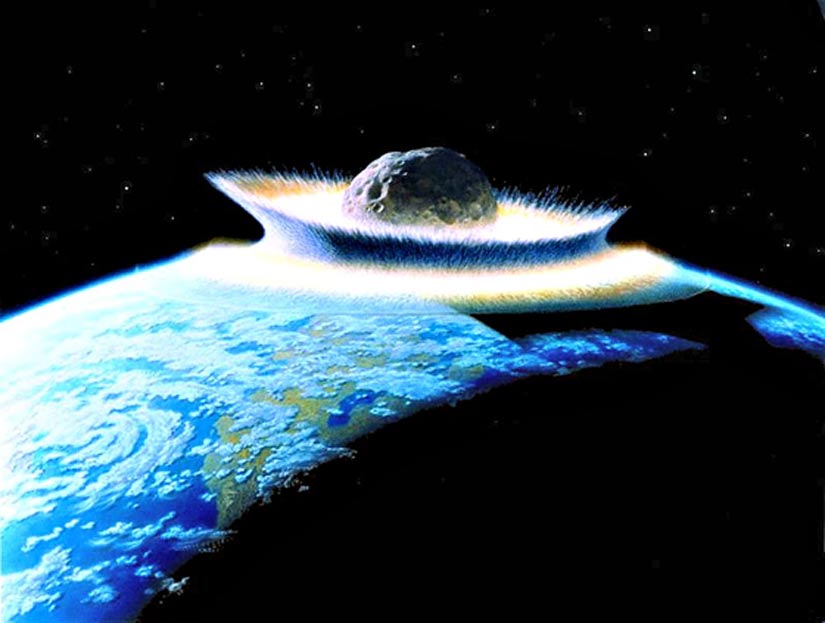Studies Begin on a Crater That May Explain the Dinosaur Extinction 65 Million Years Ago
Around 65 million years ago there was a mass extinction of dinosaurs. In addition, plankton, the base of the ocean food chain, was greatly affected. Many families of brachiopods and sponges disappeared, and the remaining hard-shelled ammonites vanished. It also greatly reduced the diversity of sharks and caused most of the vegetation on Earth to disappear. In short: more than half of the animal and plant species that inhabited our planet was eliminated.
What were the causes of this mass extinction? Scientists have not yet found a concrete answer, but are generally divided on two hypotheses: the impact of an asteroid/comet or a period of abundant volcanic activity.
The hypothesis of an extraterrestrial impact is due to the discovery of a layer of rock found worldwide, under water and land, dated to the time of the extinction, which is rich in iridium: a rare metal on earth but found in a higher concentration in meteorites. Proponents of this hypothesis argue that the iridium was spread across the planet via the impact of a comet or asteroid.

Tyrannosaurus rex skeleton at the Smithsonian museum of Natural History in Washington DC. (Public Domain)
Through numerous geological studies since the 1960s, it was possible to locate a crater at Chicxulub in the northwest of the Yucatan Peninsula, with a diameter of about 180 km (111.9 miles). The crater is dated to precisely 65 million years old.
Now, during these first days of April, the European Consortium for Ocean Research Drilling (ECORD) has begun a project at the site of the crater. The project aims to unravel how the dinosaurs disappeared and how life recovered when an asteroid 14 kilometers (8.7 miles) in diameter struck the Earth.
- Do the Ica Stones prove that mankind coexisted with dinosaurs and had advanced technology?
- Did Humans Walk the Earth with Dinosaurs? Triceratops Horn Dated to 33,500 Years
As reported by the Spanish newspaper El Mundo, through this project, which has a budget of 10 million dollars, the half-submerged crater in the Gulf of Mexico will be explored to a depth of 1,500 meters (4921.3 ft.) for the first time.

This shaded relief image of Mexico's Yucatan Peninsula shows a subtle, but unmistakable, indication of the Chicxulub impact crater. Most scientists now agree that this impact was the cause of the Cretatious-Tertiary Extinction, the event 65 million years ago that marked the sudden extinction of the dinosaurs as well as the majority of life on Earth at the time. (NASA/Public Domain)
The research will be conducted by a special boat, the Myrtle, which closely resembles an oil platform: its three giant legs will allow the structure to be fixed to the seabed, avoiding problems from the rolling waves and ensuring absolute security in the laboratories.
During the first phase of the project, 600 meters (1968.5 ft.) of sediment will be drilled to reach the rock. Layer by layer, the researchers expect to discover more and more ancient remains.
- Did Elusive Dark Matter Trigger Global Mass Extinctions and Doom the Dinosaurs?
- Scientists debunk fundamentalists claim that humans lived at same time as dinosaurs
“In the Arctic we have to use three ships, two icebreakers to keep the area free of ice while the ship can drill and collect samples; here there may be other problems such as hurricanes,” Alan Stevenson, the team leader of the engineers who carry out the extractions explained to El Mundo.

The Myrtle, the boat in use for the research. (El Mundo/D.Smith/ECORD/IODP)
The project unites a multidisciplinary team of researchers from the Universidad Nacional Autónoma of Mexico, with the University of Austin, the Imperial College of London, and the British Geological Survey. Scientists from the Universidad Complutense de Madrid and three paleontologists from the Department of Earth Sciences at the Universidad of Zaragoza will also participate in the study of microscopic fossils that are found in the first offshore drilling.
The results of the different studies will be made public within one or two years. One will have to be patient, but it is worth waiting a little longer to get answers about what happened on our planet 65 million years ago.
Featured Image: Artistic representation of a meteorite striking the Earth. (Don Davis/Public Domain)
By Mariló T. A.

















